Gondwana
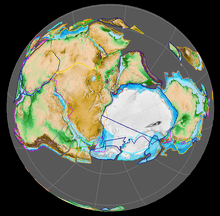
Gondwana ( /ɡɒndˈwɑːnə/),[1] or Gondwanaland,[2] was a supercontinent that existed from the Neoproterozoic (about 550 million years ago) until the Carboniferous (about 320 million years ago). It was formed by the accretion of several cratons. Eventually, Gondwana became the largest piece of continental crust of the Paleozoic Era, covering an area of about 100,000,000 km2 (39,000,000 sq mi).[3] During the Carboniferous, it merged with Euramerica to form a larger supercontinent called Pangaea. Gondwana (and Pangaea) gradually broke up during the Mesozoic Era. The remnants of Gondwana make up about two-thirds of today's continental area, including South America, Africa, Antarctica, Australia, and the Indian Subcontinent.
The formation of Gondwana began c. 800 to 650 Ma with the East African Orogeny – the collision of India and Madagascar with East Africa – and was completed c. 600 to 530 Ma with the overlapping Brasiliano and Kuunga orogenies – the collision of South America with Africa and the addition of Australia and Antarctica, respectively.[4]
Origin of concept
The continent of Gondwana was named by Austrian scientist Eduard Suess, after the Gondwana region of central northern India which is derived from Sanskrit for "forest of the Gonds". The name had been previously used in a geological context, first by H.B. Medlicott in 1872,[5] from which the Gondwana sedimentary sequences (Permian-Triassic) are also described. The term "Gondwanaland" is preferred by some scientists in order to make a clear distinction between the region and the supercontinent.[6]
Formation
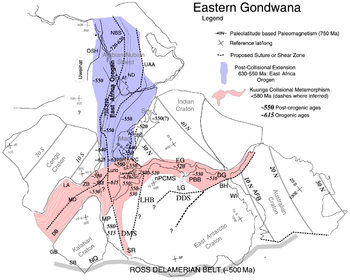
The assembly of Gondwana was a protracted process during the Neoproterozoic and Paleozoic, which however remains incompletely understood because of the lack of paleo-magnetic data. Several orogenies, collectively known as the Pan-African orogeny, led to the amalgamation of most of the continental fragments of a much older supercontinent, Rodinia. One of those orogenic belts, the Mozambique Belt, formed 800 to 650 Ma and was originally interpreted as the suture between East (India, Madagascar, Antarctica, and Australia) and West Gondwana (Africa and South America). Three orogenies were recognized during the 1990s: the East African Orogeny (650 to 800 Ma) and Kuunga orogeny (including the Malagasy Orogeny in southern Madagascar) (550 Ma) – the collision between East Gondwana and East Africa in two steps, and the Brasiliano orogeny (660 to 530 Ma) – the collision between South American and African cratons.[8]
The final stages of Gondwanan assembly overlapped with the opening of the Iapetus Ocean between Laurentia and western Gondwana.[9] During this interval, the Cambrian explosion occurred. Laurentia was docked against the western shores of a united Gondwana for a short period near the Precambrian/Cambrian boundary, forming the short-lived and still disputed supercontinent Pannotia.[10]
The Mozambique Ocean separated the Congo–Tanzania–Bangweulu Block of central Africa from Neoproterozoic India (India, the Antongil Block in far eastern Madagascar, the Seychelles, and the Napier and Rayner Complexes in East Antarctica). The Azania continent[11] (much of central Madagascar, the Horn of Africa and parts of Yemen and Arabia) was an island in the Mozambique Ocean.
The Australia/Mawson continent was still separated from India, eastern Africa, and Kalahari by c. 600 Ma, when most of western Gondwana had already been amalgamated. By c. 550 Ma, India had reached its Gondwanan position, which initiated the Kuunga orogeny (also known as the Pinjarra orogeny). Meanwhile, on the other side of the newly forming Africa, Kalahari collided with Congo and Rio de la Plata which closed the Adamastor Ocean. c. 540–530 Ma, the closure of the Mozambique Ocean brought India next to Australia–East Antarctica, and both North and South China were located in proximity to Australia.[12]
Other blocks which helped to form parts of the Southern Cone of South America, including a piece transferred from Laurentia when the west edge of Gondwana scraped against southeast Laurentia in the Ordovician.[13] This is the Cuyania or Precordillera terrane of the Famatinian orogeny in northwest Argentina which may have continued the line of the Appalachians southwards.[14]
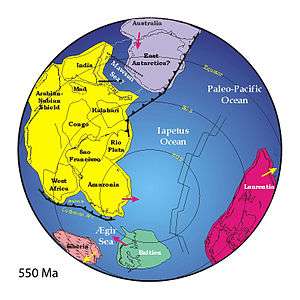
As the rest of Gondwana formed, a complex series of orogenic events assembled the eastern parts of Gondwana (eastern Africa, Arabian-Nubian Shield, Seychelles, Madagascar, India, Sri Lanka, East Antarctica, and Australia) c. 750 to 530 Ma. First the Arabian-Nubian Shield collided with eastern Africa (in the Kenya-Tanzania region) in the East African Orogeny c.750 to 620 Ma. Then Australia and East Antarctica were merged with the remaining Gondwana c. 570 to 530 Ma in the Kuunga Orogeny.[15]
The later Malagasy orogeny at about 550–515 Mya affected Madagascar, eastern East Africa and southern India. In it, Neoproterozoic India collided with the already combined Azania and Congo–Tanzania–Bangweulu Block, suturing along the Mozambique Belt.[16]
The 18,000 km (11,000 mi)-long Terra Australis Orogen developed along Gondwana's western, southern, and eastern margins.[17] Proto-Gondwanan Cambrian arc belts from this margin have been found in eastern Australia, Tasmania, New Zealand, and Antarctica. Though these belts formed a continuous arc chain, the direction of subduction was different between the Australian-Tasmanian and New Zealand-Antarctica arc segments.[18]
Gondwana as part of Pangaea
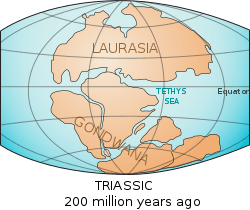
Gondwana and Laurasia formed the Pangaea supercontinent during the Carboniferous. Pangaea began to break up in the Mid-Jurassic when the Central Atlantic opened.[20]
In the western end of Pangaea, the collision between Gondwana and Laurasia closed the Rheic and Palaeo-Tethys oceans. The obliquity of this closure resulted in the docking of some northern terranes in the Marathon, Ouachita, Alleghanian, and Variscan orogenies, respectively. Southern terranes, such as Chortis and Oaxaca, on the other hand, remained largely unaffected by the collision along the southern shores of Laurentia. Some Peri-Gondwanan terranes, such as Yucatán and Florida, were buffered from collisions by major promontories. Other terranes, such as Carolina and Meguma, were directly involved in the collision. The final collision resulted in the Variscan-Appalachian Mountains, stretching from present-day Mexico to southern Europe. Meanwhile, Baltica collided with Siberia and Kazakhstania which resulted in the Uralian orogeny and Laurasia. Pangaea was finally amalgamated in the Late Carboniferous-Early Permian, but the oblique forces continued until Pangaea began to rift in the Triassic.[21]
In the eastern end collisions occurred slightly later. The North China, South China, and Indochina blocks rifted from Gondwana during the middle Paleozoic and opened the Proto-Tethys Ocean. North China docked with Mongolia and Siberia during the Carboniferous–Permian, followed by South China. The Cimmerian blocks then rifted from Gondwana to form the Palaeo-Thethys and Neo-Tethys oceans in the Late Carboniferous, and docked with Asia during the Triassic and Jurassic. Western Pangaea began to rift while the eastern end was still being assembled.[22]
The formation of Pangaea and its mountains had a tremendous impact on global climate and sea levels, which resulted in glaciations and continent-wide sedimentation. In North America, the base of the Absaroka sequence coincides with the Alleghanian and Ouachita orogenies and are indicative of a large-scale change in the mode of deposition far away from the Pangaean orogenies. Ultimately, these changes contributed to the Permian–Triassic extinction event and left large deposits of hydrocarbons, coal, evaporite, and metals.[23]
The break-up of Pangaea began with the Central Atlantic magmatic province (CAMP) between South America, Africa, North America, and Europe. CAMP covered more than seven million square kilometres over a few million years, reached its peak at c. 200 Ma, and coincided with the Triassic–Jurassic extinction event.[24] The reformed Gondwanan continent was not precisely the same as that which had existed before Pangaea formed; for example, most of Florida and southern Georgia and Alabama is underlain by rocks that were originally part of Gondwana, but this region stayed attached to North America when the Central Atlantic opened.[25]
Peri-Gondwana
A large number of terranes were accreted to Eurasia during Gondwana's existence but the Cambrian or Precambrian origin of many of these terranes remains uncertain. For example, some Palaeozoic terranes and microcontinents that now make up Central Asia, often called the "Kazakh" and "Mongolian terranes", were progressively amalgamated into the continent Kazakhstania in the Late Silurian. Whether these blocks originated on the shores of Gondwana is not known.[26]
In the Early Palaeozoic the Armorican terrane, which today form large parts of France, was part of either Peri-Gondwana or core Gondwana; the Rheic Ocean closed in front of it and the Palaeo-Tethys Ocean opened behind it. Precambrian rocks from the Iberian Peninsula suggest it too probably formed part of core Gondwana before its detachment as an orocline in the Variscan orogeny close to the Carboniferous–Permian boundary.[27]
South-east Asia is made of Gondwanan and Cathaysian continental fragments that were assembled during the Mid-Palaeozoic and Cenozoic. This process can be divided into three phases of rifting along Gondwana's northern margin: firstly, in the Devonian, North and South China, together with Tarim and Quidam (north-western China) rifted, opening the Palaeo-Tethys behind them. These terranes accreted to Asia during Late Devonian and Permian. Secondly, in the Late Carboniferous to Early Permian, Cimmerian terranes opened Meso-Tethys Ocean; Sibumasu and Qiantang were added to south-east Asia during Late Permian and Early Jurassic. Thirdly, in the Late Triassic to Late Jurassic, Lhasa, West Burma, Woyla terranes opened the Neo-Tethys Ocean; Lhasa collided with Asia during the Early Cretaceous, and West Burma and Woyla during the Late Cretaceous.[28]
During the Neoproterozoic to Palaeozoic phase of the Terra Australis orogen a series of terranes were rafted from the Andean margin when the Iapteus Ocean opened, to be added back to Gondwana during the closure of that ocean.[29]
Gondwana's long, northern margin had remained a mostly passive margin throughout the Palaeozoic. The Early Permian opening of the Neo-Tethys Ocean along this margin produced a long series of terranes, many of which were and still are being deformed in the Himalaya Orogeny. From Turkey to north-eastern India: the Taurides in southern Turkey; the Lesser Caucasus Terrane in Georgia; the Sanand, Alborz, and Lut terranes in Iran; the Mangysglak or Kopetdag Terrane in the Caspian Sea; the Afghan Terrane; the Karakorum Terrane in northern Pakistan; and the Lhasa and Qiangtang terranes in Tibet. The Permian–Triassic widening of the Neo-Tethys pushed all these terranes across the Equator and over to Eurasia.[30]
Break-up
Mesozoic
Antarctica, the centre of the supercontinent, shared boundaries with all other Gondwana continents and the fragmentation of Gondwana propagated clockwise around it. The break-up was the result of one of the Earth's most extensive large igneous provinces c. 200 to 170 Ma, but the oldest magnetic anomalies between South America, Africa, and Antarctica are found in what is now the southern Weddell Sea where initial break-up occurred during the Jurassic c. 160 to 180 Ma.[31]
Opening of western Indian Ocean
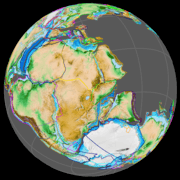

Gondwana began to break up in the early Jurassic following the extensive and fast emplacement of the Karoo-Ferrar flood basalts c. 184 Ma. Before the Karoo plume initiated rifting between Africa and Antarctica, it separated a series of smaller continental blocks from Gondwana's southern, Proto-Pacific margin (along what is now the Transantarctic Mountains): the Antarctic Peninsula, Marie Byrd Land, Zealandia, and Thurston Island; the Falkland Islands and Ellsworth–Whitmore Mountains (in Antarctica) were rotated 90° in opposite directions; and South America south of the Gastre Fault (often referred to as Patagonia) was pushed westward.[32] The history of the Africa-Antarctica break-up can be studied in great detail in the fracture zones and magnetic anomalies flanking the Southwest Indian Ridge.[33]
The Madagascar block and the Mascarene Plateau, stretching from the Seychelles to Réunion, were broken off India; elements of this breakup nearly coincide with the Cretaceous–Paleogene extinction event. The India–Madagascar–Seychelles separations appear to coincide with the eruption of the Deccan basalts, whose eruption site may survive as the Réunion hotspot. The Seychelles and the Maldives are now separated by the Central Indian Ridge.
During the initial break-up in the Early Jurassic a marine transgression swept over the Horn of Africa covering Triassic planation surfaces with sandstone, limestone, shale, marls and evaporites.[34][35]
Opening of eastern Indian Ocean
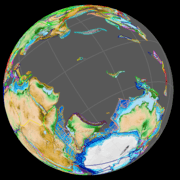


East Gondwana, comprising Antarctica, Madagascar, India, and Australia, began to separate from Africa. East Gondwana then began to break up c. 132.5 to 96 Ma when India moved northwest from Australia-Antarctica.[36] The Indian Plate and the Australian Plate are now separated by the Capricorn Plate and its diffuse boundaries.[37] During the opening of the Indian Ocean, the Kerguelen hotspot first formed the Kerguelen Plateau on the Antarctic Plate c. 118 to 95 Ma and then the Ninety East Ridge on the Indian Plate at c. 100 Ma.[38] The Kerguelen Plateau and the Broken Ridge, the southern end of the Ninety East Ridge, are now separated by the Southeast Indian Ridge.
Separation between Australia and East Antarctica began c. 132 Ma with sea-floor spreading occurring c. 96 Ma. A shallow seaway developed over the South Tasman Rise during the Early Cenozoic and as oceanic crust started to separate the continents during the Eocene c. 35.5 Ma global ocean temperature dropped significantly.[39] A dramatic shift from arc- to rift magmatism c. 100 Ma separated Zealandia, including New Zealand, the Campbell Plateau, Chatham Rise, Lord Howe Rise, Norfolk Ridge, and New Caledonia, from West Antarctica c. 84 Ma.[40]
Opening of South Atlantic Ocean
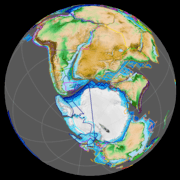
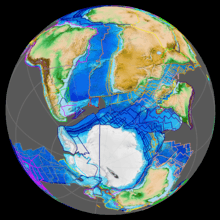
The opening of the South Atlantic Ocean divided West Gondwana (South America and Africa), but there is a considerable debate over the exact timing of this break-up. Rifting propagated from south to north along Triassic–Early Jurassic lineaments, but intra-continental rifts also began to develop within both continents in Jurassic–Cretaceous sedimentary basins; subdividing each continent into three sub-plates. Rifting began c. 190 Ma at Falkland latitudes, forcing Patagonia to move relative to the still static remainder of South America and Africa, and this westward movement lasted until the Early Cretaceous 126.7 Ma. From there rifting propagated northward during the Late Jurassic c. 150 Ma or Early Cretaceous c. 140 Ma most likely forcing dextral movements between sub-plates on either side. South of the Walvis Ridge and Rio Grande Rise the Paraná and Etendeka magmatics resulted in further ocean-floor spreading c. 130 to 135 Ma and the development of rifts systems on both continents, including the Central African Rift System and the Central African Shear Zone which lasted until c. 85 Ma. At Brazilian latitudes spreading is more difficult to assess because of the lack of palaeo-magnetic data, but rifting occurred in Nigeria at the Benue Trough c. 118 Ma. North of the Equator the rifting began after 120.4 Ma and continued until c. 100 to 96 Ma.[41]
Early Andean orogeny
The first phases of Andean orogeny in the Jurassic and Early Cretaceous were characterized by extensional tectonics, rifting, the development of back-arc basins and the emplacement of large batholiths.[42][43] This development is presumed to have been linked to the subduction of cold oceanic lithosphere.[43] During the mid to Late Cretaceous (ca. 90 million years ago) the Andean orogeny changed significantly in character.[42][43] Warmer and younger oceanic lithosphere is believed to have started to be subducted beneath South America around this time. Such kind of subduction is held responsible not only for the intense contractional deformation that different lithologies were subject to, but also the uplift and erosion known to have occurred from the Late Cretaceous onward.[43] Plate tectonic reorganization since the mid-Cretaceous might also have been linked to the opening of the South Atlantic Ocean.[42] Another change related to mid-Cretaceous plate tectonic changes was the change of subduction direction of the oceanic lithosphere that went from having south-east motion to having a north-east motion at about 90 million years ago.[44] While subduction direction changed it remained oblique (and not perpendicular) to the coast of South America, and the direction change affected several subduction zone-parallel faults including Atacama, Domeyko and Liquiñe-Ofqui.[43][44]
Cenozoic
The Indian subcontinent began to collide with Asia c. 70 Ma since when more than 1,400 km (870 mi) of crust has been absorbed by the Himalayan-Tibetan orogen. During the Cenozoic the orogen resulted in the construction of the Tibetan Plateau between the Tethyan Himalayas in the south and the Kunlun and Qilian mountains in the north.[45]
Later, South America was connected to North America via the Isthmus of Panama, cutting off a circulation of warm water and thereby making the Arctic colder,[46] as well as allowing the Great American Interchange.
The breakup of Gondwana can be said to continue in eastern Africa at the Afar Triple Junction, which separates the Arabian, Nubian, and Somali plates, resulting in rifting in the Red Sea and East African Rift.[47]
Australia–Antarctica separation
In the Early Cenozoic Australia was still connected to Antarctica c. 35–40° south of its current location and both continents were largely unglaciated. A rift between the two developed but remained an embayment until the Eocene-Oligocene boundary when the Circumpolar Current developed and the glaciation of Antarctica began.[48]
Australia was warm and wet during the Palaeocene and dominated by rainforest. The opening of the Tasman Gateway at the Eocene-Oligocene boundary (33 Ma) resulted in abrupt cooling but the Oligocene became a period of high rainfall with swamps in southeast Australia. During the Miocene a warm and humid climate developed with pockets of rainforests in central Australia but before the end of the period colder and drier climate severely reduced this rainforest. A brief period of increased rainfall in the Pliocene was followed by drier climate which favoured grassland. Since then the fluctuation between wet interglacial periods and dry glacial periods has developed into the present arid regime. Australia has thus experienced various climate changes over a 15 million year period with a gradual decrease in precipitation.[49]
The Tasman Gateway between Australia and Antarctica began to open c. 40 to 30 Ma. Palaeontological evidences indicate the Antarctic Circumpolar Current (ACC) was established in the Late Oligocene c. 23 Ma with the full opening of the Drake Passage and the deepening of the Tasman Gateway. The oldest oceanic crust in the Drake Passage, however, is 34 to 29 Ma-old which indicates spreading between the Antarctic and South American plates began near the Eocene/Oligocene boundary.[50] Deep sea environments in Tierra del Fuego and the North Scotia Ridge during the Eocene and Oligocene indicate a "Proto-ACC" opened during this period. Later, 26 to 14 Ma, a series of events severally restricted the Proto-ACC: change to shallow marine conditions along the North Scotia Ridge; closure of the Fuegan Seaway, the deep sea that existed in Tierra del Fuego; and uplift of the Patagonian Cordillera. This, together with the reactivated Iceland plume, contributed to global warming. During the Miocene, the Drake Passage began to widen and as water flow between South America and the Antarctic Peninsula increased, the renewed ACC resulted in cooler global climate.[51]
Since the Eocene the northward movement of the Australian Plate has resulted in an arc-continent collision with the Philippine and Caroline plates and the uplift of the New Guinea Highlands.[52] From the Oligocene to the late Miocene, the climate in Australia, dominated by warm and humid rainforests before this collision, began to alternate between open forest and rainforest before the continent became the arid or semiarid landscape it is today.[53]
Biogeography
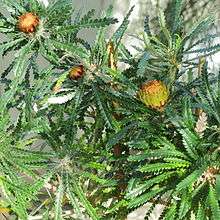
The adjective "Gondwanan" is in common use in biogeography when referring to patterns of distribution of living organisms, typically when the organisms are restricted to two or more of the now-discontinuous regions that were once part of Gondwana, including the Antarctic flora.[6] For example, the plant family Proteaceae, known from all continents in the Southern Hemisphere, has a "Gondwanan distribution" and is often described as an archaic, or relict, lineage. The distributions in Proteaceae is, nevertheless, the result of both Gondwanan rafting and later oceanic dispersal.[54]
Post-Cambrian diversification
During the Silurian Gondwana extended from the Equator (Australia) to the South Pole (North Africa and South America) whilst Laurasia was located on the Equator opposite to Australia. A short-lived Late Ordovician glaciation was followed by a Silurian Hot House period.[55] The End-Ordovician extinction, which resulted in 27% of marine invertebrate families and 57% of genera going extinct, occurred during this shift from Ice House to Hot House.[56]
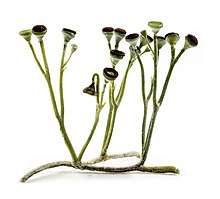
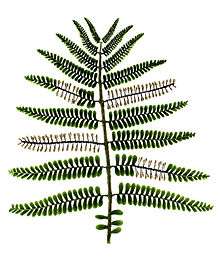
By the end of the Ordovician Cooksonia, a slender, ground-covering plant, became the first vascular plant to establish itself on land. This first colonisation occurred exclusively around the Equator on landmasses then limited to Laurasia and, in Gondwana, to Australia. In the Late Silurian two distinctive linages, zosterophylls and rhyniophytes, had colonised the tropics. The former evolved into the lycopods, that were to dominate the Gondwanan vegetation over a long period, whilst the latter evolved into horsetails and gymnosperms. Most of Gondwana was located far from the Equator during this period and remained a lifeless and barren landscape.[57]
West Gondwana drifted north during the Devonian which brought Gondwana and Laurasia close together. Global cooling contributed to the Late Devonian extinction (19% of marine families and 50% of genera went extinct) and glaciation occurred in South America. Before Pangaea had formed terrestrial plants, such as pteridophytes, began to diversify rapidly resulting in the colonisation of Gondwana. The Baragwanathia Flora, found only in the Yea Beds of Victoria, Australia, occurs in two strata separated by 1,700 m (5,600 ft) or 30 Ma; the upper assemblage is more diverse and includes Baragwanathia, the first primitive herbaceous lycopod to evolve from the zosterophylls. During the Devonian giant club mosses replaced the Baragwanathia Flora, introducing the first trees, and by the Late Devonian this first forest was accompanied by the progymnosperms, including the first large trees Archaeopteris.[58] The Late Devonian extinction probably also resulted in osteolepiform fishes evolving into the amphibian tetrapods, the earliest land vertebrates, in Greenland and Russia. The only traces of this evolution in Gondwana are amphibian footprints and a single jaw from Australia.[59]
The closure of the Rheic Ocean and the formation of Pangaea in the Carboniferous resulted in the rerouting of ocean currents which initiated an Ice House period. As Gondwana began to rotate clockwise, Australia shifted south to more temperate latitudes. An ice cap initially covered most of southern Africa and South America but began to spread to eventually cover most of the supercontinent, save for northern-most Africa-South America and eastern Australia. Giant lycopod and horsetail forests continued to evolve in tropical Laurasia together with a diversified assemblage of true insects. In Gondwana, in contrast, ice and, in Australia, volcanism decimated the Devonian flora to a low-diversity seed fern flora – the pteridophytes were increasingly replaced by the gymnosperms which were to dominate until the Mid-Cretaceous. Australia, however, was still located near the Equator during the Early Carboniferous and during this period temnospondyl and lepospondyl amphibians and the first amniote reptilians evolved, all closely related to the Laurasian fauna, but spreading ice eventually drove these animals away from Gondwana entirely.[60]
The Gondwana ice sheet melted and sea levels dropped during the Permian and Triassic global warming. During this period, the extinct glossopterids colonised Gondwana and reached peak diversity in the Late Permian when coal-forming forests covered much of Gondwana. The period also saw the evolution of Voltziales; one of the few plant orders to survive the end-Permian extinction (57% of marine families and 83% of genera went extinct) which came to dominate in the Late Permian and from whom true conifers evolved. Tall lycopods and horsetails dominated the wetlands of Gondwana in the Early Permian. Insects co-evolved with glossopterids across Gondwana and diversified with more than 200 species in 21 orders by the Late Permian, many known from South Africa and Australia. Beetles and cockroaches remained minor elements in this fauna. Tetrapod fossils from the Early Permian have only been found in Laurasia but they became common in Gondwana later during the Permian. The arrival of the therapsids resulted in the first plant-vertebrate-insect ecosystem.[61]
Modern diversification
During the Mid- to Late Triassic hot house conditions coincided with a peak in biodiversity — the end-Permian extinction was enormous and so was the radiation that followed. Two families of conifers, Podocarpaceae and Araucariaceae, dominated Gondwana in the Early Triassic, but Dicroidium, an extinct genus of fork-leaved seed ferns, dominated woodlands and forests of Gondwana during most of the Triassic. Conifers evolved and radiated during the period with six of eight extant families already present before the end of it. Bennettitales and Pentoxylales, two now extinct orders of gymnospermous plants, evolved in the Late Triassic and became important in the Jurassic and Cretaceous. It is possible that gymnosperm biodiversity surpassed later angiosperm biodiversity and that the evolution of angiosperms began during the Triassic but, if so, in Laurasia rather than in Gondwana. Two Gondwanan classes, lycophytes and sphenophytes, saw a gradual decline during the Triassic while ferns, though never dominant, managed to diversify.[62]
The brief ice house of the Triassic–Jurassic extinction event had a dramatic impact on dinosaurs but left plants largely unaffected. The Jurassic was mostly a hot house and while vertebrates managed to diversify in this environment, plants have left little evidence of such development, with the exception of Cheiroleidiacean conifers and Caytoniales and other groups of seed ferns. In terms of biomass the Jurassic flora was dominated by conifers families and other gymnosperms that had evolved during the Triassic. The Pteridophytes, that had dominated during the Palaeozoic, were now marginalised, except for ferns. In contrast to Laurentia, very few insect fossils have been found in Gondwana to a large extent because of widespread deserts and volcanism. While plants had a cosmopolitan distribution, dinosaur evolved and diversified in a pattern that reflects the Jurassic break-up of Panagaea.[63]
The Cretaceous saw the arrival of the angiosperms, or flowering plants, a group that probably evolved in western Gondwana (South America-Africa). From there the angiosperms diversified in two stages: the monocots and magnoliids evolved in the Early Cretaceous followed by the hammamelid dicots. By the Mid-Cretaceous angiosperms constituted half of the flora in northeastern Australia. There is, however, no obvious connection between this spectacular angiosperm radiation and an extinction event nor vertebrate/insect evolution. Insect orders associated with pollination, such as beetles, flies, butterflies and moths, and wasps, bees, and ants, radiated continuously from the Permian-Triassic long before the arrival of the angiosperms. Well-preserved insect fossils have been found in the lake deposits of the Santana Formation in Brazil, the Koonwarra Lake fauna in Australia, and the Orapa diamond mine in Botswana.[64] Dinosaurs continued to prosper but, as the angiosperm diversified, conifers, bennettitaleans and pentoxylaleans disappeared from Gondwana c. 115 Ma together with the specialised herbivorous ornithischians whilst generalist browsers such as several families of sauropodomorph Saurischia prevailed. The Cretaceous–Paleogene extinction event killed off all dinosaurs except birds, but plant evolution in Gondwana was hardly affected by the event.[64] Gondwanatheria is an extinct group of non-therian mammals with a Gondwanan distribution (South America, Africa, Madagascar, India, and Antarctica) during the Late Cretaceous and Palaeogene.[65] Xenarthra and Afrotheria, two placental clades, are of Gondwanan origin and probably began to evolve separately c. 105 Ma when Africa and South America separated.[66]
The laurel forest of Australia, New Caledonia, and New Zealand have a number of other related species of the laurissilva de Valdivia, through the connection of the Antarctic flora as gymnosperms and deciduous angiosperm Nothofagus. Corynocarpus laevigatus is called the bay of New Zealand, Laurelia novae-zelandiae belongs to the same genus Laurelia. The sempervirens tree niaouli grows in Australia, New Caledonia, and New Zealand. New Caledonia and New Zealand ecoregions became separated from Australia by continental drift 85 million years ago. The islands still retain plants that originated in Gondwana and spread to the Southern Hemisphere continents later. However, strong evidence exists of glaciation during the Carboniferous to Permian time, especially in South Africa.
See also
- Continental drift, the movement of the Earth's continents relative to each other
- Australasian realm
- Gondwana Rainforests of Australia
- The Great Escarpment of Southern Africa
- Plate tectonics, a theory which describes the large-scale motions of Earth's lithosphere
- South Polar dinosaurs, which proliferated during the Early Cretaceous (145–100 Mya) while Australia was still linked to Antarctica to form East Gondwana
- Tarkine wilderness
References
Notes
- ↑ "Gondwana". Dictionary.com. Lexico Publishing Group. Retrieved 18 January 2010.
- ↑ "Gondwanaland". Merriam-Webster Online Dictionary. Retrieved 18 January 2010.
- ↑ Torsvik & Cocks 2013, Abstract
- ↑ Meert & Van Der Voo 1997, Abstract
- ↑ Suess 1885, p. 768: "Wir nennen es Gondwána-Land, nach der gemeinsamen alten Gondwána-Flora, … " (We name it Gondwána-Land, after the common ancient flora of Gondwána …)
- 1 2 McLoughlin 2001, Gondwana or Gondwanaland?, pp. 272–273
- ↑ Meert 2003, Fig. 10, p. 19
- ↑ Meert & Van Der Voo 1997, Introduction, pp. 223–226
- ↑ Miashita & Yamamoto 1996
- ↑ Meert & Van Der Voo 1997, p. 229
- ↑ Defined but not named in Collins & Pisarevsky 2005: "Azania" was a Greek name for the East African coast
- ↑ Li et al. 2008, The birth of Gondwanaland (600–530 Ma), p. 201
- ↑ Rapalini 2001; Rapalini 1998, pp. 105–106
- ↑ Dalla Salda et al. 1998, Abstract; Vujovich, van Staal & Davis 2004, Conclusions, p. 1053
- ↑ Meert 2003, Abstract
- ↑ Grantham, Maboko & Eglington 2003
- ↑ Cawood 2005, Definition and Tectonic Framework, pp. 4–6
- ↑ Münker & Crawford 2000, Abstract
- ↑ Li et al. 2008, Abstract
- ↑ Torsvik & Van Der Voo 2002, Data selection and reconstruction fits, p. 772
- ↑ Blakey 2003, Assembly of Western Pangaea: Carboniferous–Permian, pp. 453–454
- ↑ Blakey 2003, Assembly of Eastern Pangaea: Late Permian–Jurassic, p. 454
- ↑ Blakey 2003, Summary: significance of Pangaean events, pp. 454–455
- ↑ Marzoli et al. 1999, Abstract
- ↑ "Gondwana Remnants in Alabama And Georgia: Uchee Is An 'Exotic' Peri-Gondwanan Arc Terrane, Not Part Of Laurentia". ScienceDaily. February 4, 2008. Retrieved 2011-10-22.
- ↑ Torsvik & Cocks 2013, Marginal microcontinents and terranes, p. 1008
- ↑ Torsvik & Cocks 2013, Southern Europe, pp. 1008–1009
- ↑ McLoughlin 2001, Cimmerian terranes, p. 278
- ↑ Cawood 2005, Peri-Gondwanan continental basement assemblages, pp. 15–16
- ↑ Torsvik & Cocks 2013, South-central and eastern Asia
- ↑ Jokat et al. 2003, Introduction, pp. 1–2
- ↑ Encarnación et al. 1996, Early rifting and Gondwana breakup, pp. 537–538
- ↑ Royer et al. 1988, Figg. 7 a–j, pp. 248–257
- ↑ Abbate, Ernesto; Bruni, Piero; Sagri, Mario (2015). "Geology of Ethiopia: A Review and Geomorphological Perspectives". In Billi, Paolo. Landscapes and Landforms of Ethiopia. World Geomorphological Landscapes. pp. 33–64. doi:10.1007/978-94-017-8026-1_2. ISBN 978-94-017-8026-1.
- ↑ Coltorti, M.; Dramis, F.; Ollier, C.D. (2007). "Planation surfaces in Northern Ethiopia". Geomorphology. 89: 287–296.
- ↑ Powell, Roots & Veevers 1988, Abstract
- ↑ DeMets, Gordon & Royer 2005, Introduction; Fig. 1, p. 446
- ↑ Müller, Royer & Lawver 1993, Model results, pp. 277–278
- ↑ McLoughlin 2001, East Antarctica–Australia, p. 280
- ↑ McLoughlin 2001, West Antarctica–Tasmantia, p. 280
- ↑ Seton et al. 2012, South Atlantic, pp. 217–218
- 1 2 3 Ramos 2009, Abstract
- 1 2 3 4 5 Charrier, Pinto & Rodríguez 2006, pp. 45–46
- 1 2 Hoffmann-Rothe et al. 2006
- ↑ Yin & Harrison 2000, Abstract
- ↑ Luyendyk, Forsyth & Phillips 1972, Abstract
- ↑ Jestin, Huchon & Gaulier 1994, Abstract
- ↑ Martin 2006, Palaeogeography, pp. 538–539
- ↑ Martin 2006, Conclusions, pp. 557–558
- ↑ Lagabrielle et al. 2009, Timing of opening of the Drake Passage region, pp. 198–199
- ↑ Lagabrielle et al. 2009, Conclusions, p. 210
- ↑ Hill & Hall 2003, Abstract
- ↑ Travouillon et al. 2009, Abstract
- ↑ Barker et al. 2007, Abstract
- ↑ Anderson et al. 1999, SILURIAN: terrestrial life appears in the tropics, p. 148
- ↑ Anderson et al. 1999, The First Extinction, p. 151
- ↑ Anderson et al. 1999, The Silurian revolution, p. 151
- ↑ Anderson et al. 1999, DEVONIAN: colonising Gondwana; The Second Extinction; Global colonisation of plants, pp. 151, 153
- ↑ Anderson et al. 1999, Amphibian prelude, p. 153
- ↑ Anderson et al. 1999, CARBONIFEROUS: competing with ice, pp. 153–154
- ↑ Anderson et al. 1999, PERMIAN: the glossopterid empire, pp. 153–154
- ↑ Anderson et al. 1999, TRIASSIC: the gymnosperm heyday, pp. 155–156
- ↑ Anderson et al. 1999, JURASSIC: volcanism, conifers and bennettitaleans, pp. 156, 158
- 1 2 Anderson et al. 1999, CRETACEOUS: of flowers and pollination, pp. 158–159
- ↑ Gurovich & Beck 2009, Introduction, pp. 25–26
- ↑ Woodburne, Rich & Springer 2003, Gondwana and early mammal evolution, p. 375
- ↑ HaoMin & ZheKun 2007
Sources
- Anderson, J. M.; Anderson, H. M.; Archangelsky, S.; Bamford, M.; Chandra, S.; Dettmann, M.; Hill, R.; McLoughlin, S.; Rösler, O. (1999). "Patterns of Gondwana plant colonisation and diversification". Journal of African Earth Sciences. 28 (1): 145–167. Bibcode:1999JAfES..28..145A. doi:10.1016/S0899-5362(98)00083-9. Retrieved 25 November 2017.
- Barker, N. P.; Weston, P. H.; Rutschmann, F.; Sauquet, H. (2007). "Molecular dating of the 'Gondwanan'plant family Proteaceae is only partially congruent with the timing of the break‐up of Gondwana". Journal of Biogeography. 34 (12): 2012–2027. doi:10.1111/j.1365-2699.2007.01749.x. Retrieved 3 September 2017.
- Blakey, R. C. (2003). "Carboniferous–Permian paleogeography of the assembly of Pangaea". In Wong, Th. E. Proceedings of the XVth International Congress on Carboniferous and Permian Stratigraphy. Utrecht (Vol. 10, p. 16). Utrecht, the Netherlands: Royal Netherlands Academy of Arts and Sciences.
- Cawood, Peter A. (2005). "Terra Australis Orogen: Rodinia breakup and development of the Pacific and Iapetus margins of Gondwana during the Neoproterozoic and Paleozoic". Earth-Science Reviews. 69 (3): 249–279. Bibcode:2005ESRv...69..249C. doi:10.1016/j.earscirev.2004.09.001.
- Charrier, Reynaldo; Pinto, Luisa; Rodríguez, María Pía (2006). "3. Tectonostratigraphic evolution of the Andean Orogen in Chile". In Moreno, Teresa; Gibbons, Wes. Geology of Chile. Geological Society of London. pp. 21–114. ISBN 9781862392199.
- Collins, A. S.; Pisarevsky, S. A. (2005). "Amalgamating eastern Gondwana: The evolution of the Circum-Indian Orogens". Earth-Science Reviews. 71 (3–4): 229–270. Bibcode:2005ESRv...71..229.. CiteSeerX 10.1.1.558.5911. doi:10.1016/j.earscirev.2005.02.004.
- Dalla Salda, L. H.; de Luchi, M. G. L.; Cingolani, C. A.; Varela, R. (1998). "Laurentia-Gondwana collision: the origin of the Famatinian-Appalachian orogenic belt (a review)". Geological Society, London, Special Publications. 142 (1): 219–234. Bibcode:1998GSLSP.142..219D. doi:10.1144/GSL.SP.1998.142.01.11. Retrieved 10 September 2017.
- DeMets, C.; Gordon, R. G.; Royer, J. Y. (2005). "Motion between the Indian, Capricorn and Somalian plates since 20 Ma: implications for the timing and magnitude of distributed lithospheric deformation in the equatorial Indian ocean" (PDF). Geophysical Journal International. 161 (2): 445–468. Bibcode:2005GeoJI.161..445D. doi:10.1111/j.1365-246X.2005.02598.x. Retrieved 1 October 2017.
- Encarnación, J.; Fleming, T. H.; Elliot, D. H.; Eales, H. V. (1996). "Synchronous emplacement of Ferrar and Karoo dolerites and the early breakup of Gondwana". Geology. 24 (6): 535–538. doi:10.1130/0091-7613(1996)0242.3.CO;2 (inactive 2018-09-21). ISSN 0091-7613.
- Grantham, G. H.; Maboko, M.; Eglington, B. M. (2003). "A review of the evolution of the Mozambique Belt and implications for the amalgamation and dispersal of Rodinia and Gondwana". Geological Society, London, Special Publications. 206 (1): 401–425. Bibcode:2003GSLSP.206..401G. doi:10.1144/GSL.SP.2003.206.01.19. Retrieved 3 September 2017.
- Gurovich, Y.; Beck, R. (2009). "The phylogenetic affinities of the enigmatic mammalian clade Gondwanatheria". Journal of Mammalian Evolution. 16 (1): 25–49. doi:10.1007/s10914-008-9097-3. Retrieved 11 February 2018.
- HaoMin, Li; ZheKun, Zhou (1 September 2007). "Fossil Nothofagaceous Leaves from the Eocene of Western Antarctica and their Bearing on the Origin, Dispersal and Systematics of Nothofagus" (PDF). Science in China Series D: Earth Sciences. 50 (10): 1525–1535. doi:10.1007/s11430-007-0102-0. Retrieved 10 September 2017.
- Hill, K. C.; Hall, R. (2003). "Mesozoic-Cenozoic evolution of Australia's New Guinea margin in a west Pacific context" (PDF). In Hillis, R. R.; Müller, R. D. Evolution and Dynamics of the Australian Plate. Geological Society of America. pp. 265–290. ISBN 9780813723723. Retrieved 27 January 2018.
- Hoffmann-Rothe, Arne; Kukowski, Nina; Dresen, Georg; Echtler, Helmut; Oncken, Onno; Klotz, Jürgen; Scheuber, Ekkehard; Kellner, Antje (2006). "Oblique Convergence along the Chilean Margin: Partitioning, Margin-Parallel Faulting and Force Interaction at the Plate Interface". In Oncken, Onno; Chong, Guillermo; Franz, Gerhard; Giese, Peter; Götze, Hans-Jürgen; Ramos, Víctor A.; Strecker, Manfred R.; Wigger, Peter. The Andes: Active Subduction Orogeny. Berlin, Heidelberg: Springer. pp. 125–146. doi:10.1007/978-3-540-48684-8_6. ISBN 978-3-540-24329-8. Retrieved 27 January 2018.
- Jestin, F.; Huchon, P.; Gaulier, J. M. (1994). "The Somalia plate and the East African Rift System: present-day kinematics". Geophysical Journal International. 116 (3): 637–654. Bibcode:1994GeoJI.116..637J. CiteSeerX 10.1.1.876.4499. doi:10.1111/j.1365-246X.1994.tb03286.x.
- Jokat, W.; Boebel, T.; König, M.; Meyer, U. (2003). "Timing and geometry of early Gondwana breakup". Journal of Geophysical Research: Solid Earth. 108 (B9): 2428. Bibcode:2003JGRB..108.2428J. doi:10.1029/2002JB001802. Retrieved 1 October 2017.
- Lagabrielle, Y.; Goddéris, Y.; Donnadieu, Y.; Malavieille, J.; Suarez, M. (2009). "The tectonic history of Drake Passage and its possible impacts on global climate" (PDF). Earth and Planetary Science Letters. 279 (3): 197–211. Bibcode:2009E&PSL.279..197L. doi:10.1016/j.epsl.2008.12.037. Retrieved 26 November 2017.
- Li, Z. X.; Bogdanova, S. V.; Collins, A. S.; Davidson, A.; De Waele, B.; Ernst, R. E.; Fitzsimons, I. C. W.; Fuck, R. A.; Gladkochub, D. P.; Jacobs, J.; Karlstrom, K. E.; Lu, S.; Natapov, L. M.; Pease, V.; Pisarevsky, S. A.; Thrane, K.; Vernikovsky, V. (2008). "Assembly, configuration, and break-up history of Rodinia: a synthesis" (PDF). Precambrian Research. 160 (1): 179–210. Bibcode:2008PreR..160..179L. doi:10.1016/j.precamres.2007.04.021. Retrieved 30 September 2017.
- Luyendyk, B. P.; Forsyth, D.; Phillips, J. D. (1972). "Experimental Approach to the Paleocirculation of the Oceanic Surface Waters" (PDF). Geological Society of America Bulletin. 83 (9): 2649. doi:10.1130/0016-7606(1972)83[2649:eattpo]2.0.co;2. Retrieved 1 September 2017.
- Martin, H. A. (2006). "Cenozoic climatic change and the development of the arid vegetation in Australia" (PDF). Journal of Arid Environments. 66 (3): 533–563. Bibcode:2006JArEn..66..533M. doi:10.1016/j.jaridenv.2006.01.009. Retrieved 26 November 2017.
- Marzoli, A.; Renne, P. R.; Piccirillo, E. M.; Ernesto, M.; Bellieni, G.; De Min, A. (1999). "Extensive 200-million-year-old continental flood basalts of the Central Atlantic Magmatic Province". Science. 284 (5414): 616–618. Bibcode:1999Sci...284..616M. doi:10.1126/science.284.5414.616. Retrieved 1 October 2017.
- McLoughlin, S. (2001). "The breakup history of Gondwana and its impact on pre-Cenozoic floristic provincialism". Australian Journal of Botany. 49 (3): 271–300. doi:10.1071/BT00023. Retrieved 3 September 2017.
- Meert, J. G. (2003). "A synopsis of events related to the assembly of eastern Gondwana". Tectonophysics. 362 (1): 1–40. Bibcode:2003Tectp.362....1M. doi:10.1016/S0040-1951(02)00629-7.
- Meert, J. G.; Van Der Voo, R. (1997). "The assembly of Gondwana 800-550 Ma". Journal of Geodynamics. 23 (3–4): 223–235. Bibcode:1997JGeo...23..223M. doi:10.1016/S0264-3707(96)00046-4. Retrieved 3 September 2017.
- Miashita, Y.; Yamamoto, T. (1996). "Gondwanaland: Its Formation, Evolution and Dispersion". Journal of African Earth Sciences. 23 (2): XIX. Bibcode:1996JAfES..23D..19M. doi:10.1016/s0899-5362(97)86882-0.
- Müller, R. D.; Royer, J. Y.; Lawver, L. A. (1993). "Revised plate motions relative to the hotspots from combined Atlantic and Indian Ocean hotspot tracks". Geology. 21 (3): 275–278. doi:10.1130/0091-7613(1993)021<0275:RPMRTT>2.3.CO;2. Retrieved 1 September 2017.
- Münker, C.; Crawford, A. J. (2000). "Cambrian arc evolution along the SE Gondwana active margin: a synthesis from Tasmania‐New Zealand‐Australia‐Antarctica correlations". Tectonics. 19 (3): 415–432. Bibcode:2000Tecto..19..415M. doi:10.1029/2000TC900002.
- Powell, C.; Roots, S. R.; Veevers, J. J. (1988). "Pre-Breakup Continental Extension in East Gondwanaland and the Early Opening of the Eastern Indian Ocean". Tectonophysics. 155 (1–4): 261–283. Bibcode:1988Tectp.155..261P. doi:10.1016/0040-1951(88)90269-7.
- Ramos, V. A. (2009). "Anatomy and global context of the Andes: Main geologic features and the Andean orogenic cycle". The Geological Society of America Memoir. 204: 31–65. doi:10.1130/2009.1204(02). Retrieved 15 December 2015.
- Rapalini, A. E. (2001). The Assembly of Southern South America in the Late Proterozoic and Paleozoic: Some Paleomagnetic Clues. Spring Meeting 2001. American Geophysical Union. Bibcode:2001AGUSM..GP32D03R.
|access-date=requires|url=(help) - Rapalini, A. E. (1998). "Syntectonic magnetization of the mid-Palaeozoic Sierra Grande Formation: further constraints on the tectonic evolution of Patagonia" (PDF). Journal of the Geological Society. 155 (1): 105–114. Bibcode:1998JGSoc.155..105R. doi:10.1144/gsjgs.155.1.0105. Retrieved 10 September 2017.
- Royer, J. Y.; Patriat, P.; Bergh, H. W.; Scotese, C. R. (1988). "Evolution of the Southwest Indian Ridge from the Late Cretaceous (anomaly 34) to the Middle Eocene (anomaly 20)". Tectonophysics. 155 (1–4): 235–260. Bibcode:1988Tectp.155..235R. doi:10.1016/0040-1951(88)90268-5. Retrieved 31 July 2016.
- Seton, M.; Müller, R. D.; Zahirovic, S.; Gaina, C.; Torsvik, T.; Shephard, G.; Talsma, A.; Gurnis, M.; Maus, S.; Chandler, M. (2012). "Global continental and ocean basin reconstructions since 200Ma". Earth-Science Reviews. 113 (3): 212–270. Bibcode:2012ESRv..113..212S. doi:10.1016/j.earscirev.2012.03.002. Retrieved 23 October 2016.
- Suess, E. (1885). Das Antlitz der Erde (The Face of the Earth) (in German). 1. Leipzig, Germany: G. Freytag. Retrieved 3 September 2017.
- Torsvik, T. H.; Cocks, L. R. M. (2013). "Gondwana from top to base in space and time" (PDF). Gondwana Research. 24 (3): 999–1030. Bibcode:2013GondR..24..999T. doi:10.1016/j.gr.2013.06.012. Retrieved 18 September 2013.
- Torsvik, T. H.; Voo, R. V. D. (2002). "Refining Gondwana and Pangea Palaeogeography: Estimates of Phanerozoic non‐dipole (octupole) fields" (PDF). Geophysical Journal International. 151 (3): 771–794. Bibcode:2002GeoJI.151..771T. doi:10.1046/j.1365-246X.2002.01799.x. Retrieved 16 September 2017.
- Travouillon, K. J.; Legendre, S.; Archer, M.; Hand, S. J. (2009). "Palaeoecological analyses of Riversleigh's Oligo-Miocene sites: implications for Oligo-Miocene climate change in Australia". Palaeogeography, Palaeoclimatology, Palaeoecology. 276 (1–4): 24–37. doi:10.1016/j.palaeo.2009.02.025.
- Vujovich, G. I.; van Staal, C. R.; Davis, W. (2004). "Age constraints on the tectonic evolution and provenance of the Pie de Palo Complex, Cuyania composite terrane, and the Famatinian Orogeny in the Sierra de Pie de Palo, San Juan, Argentina" (PDF). Gondwana Research. 7 (4): 1041–1056. Bibcode:2004GondR...7.1041V. doi:10.1016/S1342-937X(05)71083-2. Retrieved 10 September 2017.
- Woodburne, M. O.; Rich, T. H.; Springer, M. S. (2003). "The evolution of tribospheny and the antiquity of mammalian clades". Molecular Phylogenetics and Evolution. 28 (2): 360–385. doi:10.1016/S1055-7903(03)00113-1.
- Yin, A.; Harrison, T. M. (2000). "Geologic evolution of the Himalayan-Tibetan orogen" (PDF). Annual Review of Earth and Planetary Sciences. 28 (1): 211–280. Bibcode:2000AREPS..28..211Y. doi:10.1146/annurev.earth.28.1.211. Retrieved 26 November 2017.
External links
- Houseman, Greg. "Animation of the dispersal of Gondwanaland". University of Leeds. Retrieved 21 October 2008.
- Barend Köbben; Colin Reeves; Maarten de Wit. "Interactive animation of the breakup of Gondwana". ITC, University of Twente. Retrieved 16 October 2017.
- Graphical subjects dealing with Tectonics and Paleontology
- Gondwana Reconstruction and Dispersion
- The Gondwana Map Project
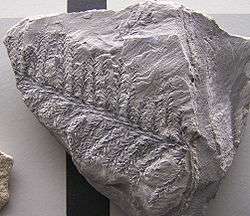
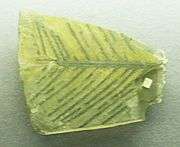

_cone.jpg)
.jpg)
.svg.png)
.svg.png)
.svg.png)
.svg.png)


.svg.png)
.svg.png)
.svg.png)
.svg.png)
.svg.png)